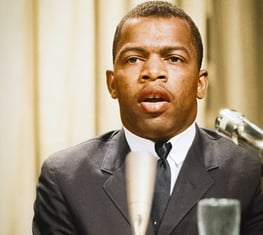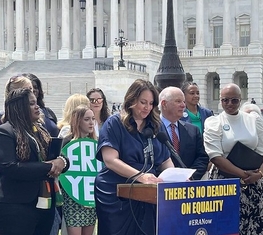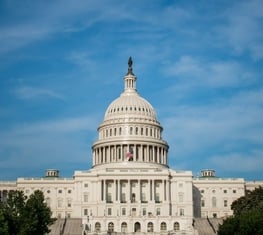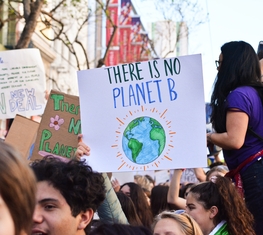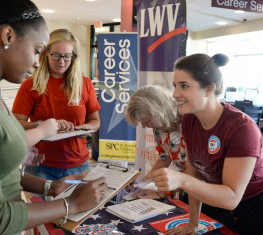The Voting Rights Act in Action
An in-depth look at how the Voting Rights Act has protected voters of color and language-minority voters—and why we need the Voting Rights Advancement Act:
A conversation with Leonard Gorman,
Executive Director of the Navajo Nation Human Rights Commission
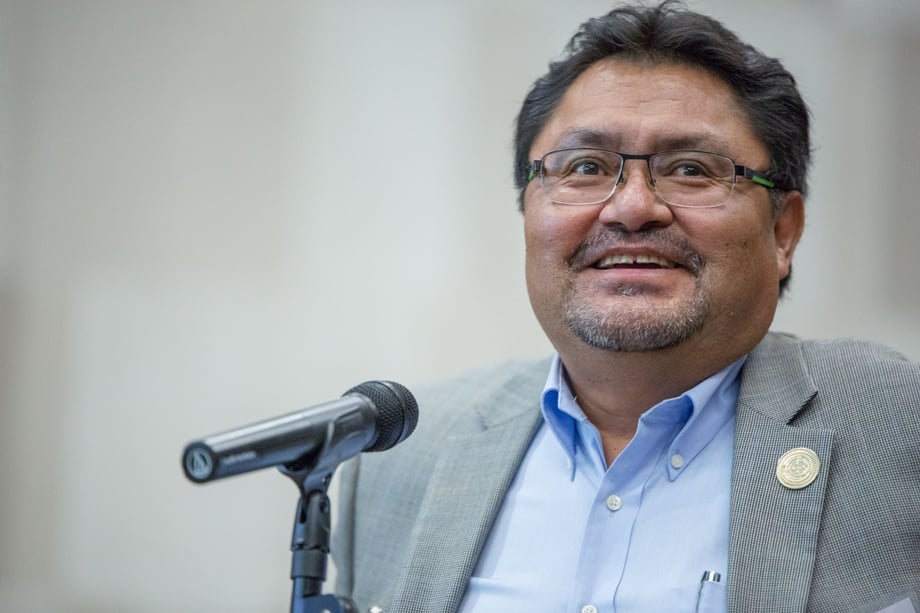
In the Southeast corner of Utah lies San Juan County, which includes part of the Navajo Nation. Native Americans make up a slight majority of San Juan County’s population. In 2016, the county switched to a primarily mail ballot system with only one physical voting location that was about a three-hour drive from the Navajo Nation. These changes would have made it very difficult for those who reside on the Navajo Nation in San Juan County to cast their ballot. Most of San Juan County’s Navajo Nation voters do not have mailboxes (or USPS address) at their physical home and use P.O. boxes that are hours or sometimes a state away in Arizona and New Mexico. In addition, many Navajo Nation voters do not have the English fluency (their Native language is Diné) required to completely understand a ballot that would be mailed in English, especially the complexities and jargon pertaining to ballot initiatives. In 2016, attorneys filed a lawsuit, Navajo Nation Human Rights Commission v. San Juan County et al, against San Juan County on behalf of the Navajo Nation Human Rights Commission (“NNHRC”) asserting the county violated sections of the Voting Rights Act of 1965 (“VRA”). The lawsuit alleged that the county was not providing effective language assistance to Navajo-speaking voters and unequal voting opportunities to Navajo voters. In 2018 the parties to the lawsuit reached a positive settlement for the Navajo Nation Human Rights Commission. The county was required to have three in-person polling places on the Navajo Nation and provide Diné (Navajo language) translators at those polling places. After these changes (along with a separate lawsuit that found the county was racially gerrymandered and resulted in new county district maps), the makeup of San Juan County’s county commission switched to a Navajo majority for the first time in over 200 years. Some county members upset with this power change, pushed to switch the county commission leadership from three to five persons, hoping to dilute Native leadership at the county level. This county commission leadership change was defeated at the polls this past November.
Last week, I talked with Leonard Gorman, Executive Director of the NNHRC, about their lawsuit, voting since the settlement agreement stipulations have gone into effect, and the importance of the Voting Rights Act of 1965 and the Voting Rights Advancement Act (VRAA) that has now advanced to the Senate. Below is a transcript of our conversation.
Rachel: How did accessibility to the ballot impact the elections results and morale of voters?
Leonard: Access to anything that’s available or that a person can acquire is always an interesting phenomenon on the Navajo Nation. Right now, off the Navajo Nation, you have access to me by phone and texting. Take 100 Navajos on the Navajo Nation; probably 90 of the 100 would have a difficult time having that access. The phone systems on the Navajo Nation often have difficulty, particularly cellphones do not have good reception. You also have to look at what is the Navajo frame of mind regarding accessibility – the Navajo frame of mind often is having the ability to touch it and see it. That’s the framework of accessibility. Then there’s the ability to understand it. So, access to ballots is a very difficult matter to assess on the Navajo Nation. The election office may think, oh we’ve mailed the ballot to the voter, which may have happened. The voter may have received [the ballot] in the mailbox and the voter may have picked it up, but the voter is unable to access that ballot. Even though [the voter] has it in their hand and may have opened the envelope they don’t have the ability to understand it. That’s the very critical part on how [accessibility or lack thereof] impacts the election results and the morale of voters. It’s very unfortunate that many a times, and I think it’s predominant across the United States, that the way the ballots are written in English, a lot of times, causes voters to have a very difficult time understanding what's going on or being voted on. This results in “I don’t want to vote on this” and the morale towards the ability to cast that ballot begins to go down. That’s the same situation for Navajo voters that require language assistance. Sometimes, when we visit with the post offices on the Navajo Nation, the postmasters will say, “at the end of the day when I emptied the trash, I found a lot of ballots in the trash can,” because there is a lack of understanding.
Rachel: So, by being able to go to a polling place in person and have translators to assist in voting, it could correct a lot of that?
Leonard: Yes, and part of the trick of this whole dynamic of understanding is really the time it takes to bring an issue to a Navajo voter. [First to] begin to digest that information, second for us to tell them these are the factors and components of the issue and oftentimes it does require an ability to analogize for the voter, so they better understand what’s going on. And that can take time. So in other words, just because you have an interpreter or a person that knows how to speak the Navajo language does not guarantee or indicate that the voter is getting the best or effective services.
Rachel: What has been the feedback of voters with the increased polling places on the Navajo Nation and the presence of translators from the past election cycle?
Part of the feedback has been, even after settling the case, we still fumbled, we still could not, in the voters' mind, make [the election process] work correctly. And that happened again in this election round in 2019. Part of the reason for this sentiment is because of the gamesmanship that is still going on and being played by the county officials. Even though they hired, whom we consider the best candidates for language assistance, the county continues to employ individual(s) who made [the election] more complicated than it should have been. Those individuals are even Navajo...As far as language assistance is concerned, it became more effective by placing ads over the radio and going to chapter meetings. Even though the time frames were not appropriate for us, we expedited all the work that needed to be done in a week or two, and it worked [to have people turn out and vote].
Rachel: So now do you have additional ideas for what needs to be done next year?
The timeframe that we have in the settlement agreement provides for engaging a certified interpreter at least two months before the election date. Six months would be preferred because that person begins to study, for example the ballot propositions and begins to digest all that information and think about how to interpret from English to Navajo the nuts and bolts of the information. Then they begin to formulate the content and context in the Navajo language that fits the wording in the English language. And that takes time. Then there is training that has to happen: training for Navajo poll workers who will be designated as persons that provide information in the Navajo language at the polling places. There will also be liaisons who attend chapter meetings and will be trained to understand the ballot and how to say the Navajo version of that ballot. The liaisons will go out into the community and explain to voters what is on the ballot. Finally, satellite offices will open (on the Navajo Nation) 4 weeks before the election date for early voting and education by the Navajo liaison and interpreter to explain the ballot measures and the basics of the candidates on the ballot. This was all supposed to happen but didn’t happen.
Rachel: What do you think would have happened if a law protecting language minority voters wasn’t on the books and you couldn’t challenge the changes San Juan County made in court?
Leonard: In that situation, it reminds me of a club or organization where unless you are a member, you wouldn’t know what’s going on inside that club – that’s the dynamics of San Juan County. There have been efforts undertaken to not let the Navajo voter know what is on their ballot. Although there are laws that require the county officials to convey election information to the Navajo voter, it didn’t happen. For the past 30 years in San Juan County, the county was under the operating standard of “don’t let them know” and unfortunately that’s what happened for years. If there were no laws in place to change those dynamics, we wouldn’t be talking about this at all.
Rachel: So sounds like having something like the VRA in place is really important for progressing change and making sure people are able to exercise their rights. With the new VRAA that will restore a lot of the original protections of the VRA, can you expand a little further on why those provisions that protect language minority voters and particularly Native voters, are important to you?
Leonard: The VRA of 1965 is a very unique law. It has the very strong potential to effectively protect Native American voters, however, it also has a double edge side and that is the law also has a tendency to measure a Native American voter based on their fluency in the English language. When you look at why Native Americans are in the position today to significantly speak only the English language, there is a history behind it. That history is that you have to take the Native American out of the Native American and the way to do that is to take their language and the ability to speak their language away from them. Unfortunately, in my opinion, that has a significant successful impact today. Measuring the Voting Rights Act based on a Native American’s fluency in the English language is really a factor that has this unintentional side effect. Our office has been advocating for, not to just recognize the fluency level issue, but the preservation of the Navajo language. There is a provision in the VRA that talks about written minority languages and talks about the historical aspect of [those] languages. Now, history is always a moving timeframe; the 1960s history is different than the 2019 history. The 2019 history says that the Navajo language is written. The 1965 history tends to ignore that although the Navajo language was being written, it is originally an unwritten language.
Rachel: Right, and isn’t when the Navajo language written, it is written with English letters?
Leonard: Yes, utilizing the English alphabet, it fits the definition of a “written language,” so, fitting the Navajo language into the protections of the VRA is still a challenge. It’s a predominant challenge for us Navajos at this point in time because the history of where we came from puts us in the position of saying today our language is not important. That’s the cleansing effect of assimilation, acculturation and colonialism and you can see it on the Navajo Nation. I am hopeful that with our ingenuity and our ability to articulate in the English language that we can preserve the Navajo language which is paramountly important. If the VRAA does not recognize preservation of native languages, it is still in the same lens as 1965 and that needs to change.
As far as the protections that existed pre-June 2013 supreme court decision (Shelby v Holder): I sit here talking to you trying to figure out a way to convince the redistricting authorities that my plan is the best plan. If those authorities don’t take into consideration my plan, I have a way and means to address [that]. I have a very difficult time finding an avenue to address my concerns without the VRA. It was great to have the section 5 preclearance – it was great. I went into the meeting room with a plan that is undeniably in compliance with the VRA and it was the election redistricting authority's responsibility to prove to me that I'm wrong. I have a very difficult time finding that again without Section 5.
Rachel: I don’t remember if the Native American Voting Rights Act addressed this concern of language preservation, but I know it addresses a lot of the unique circumstances that Native voters face that aren’t fully captured by the VRAA.
Leonard: I’m not sure either. We were party to the Native American Voting Rights Coalition. Part of the dynamics of Native Americana as it pertains to voting rights is rather interesting and uniquely fractionated. I think a significant number of Native American voters have now successfully been assimilated to the English language; whether they understand in the definition form the words they say remains a question, but they are able to conjugate very well in the English language. While there are Native Americans that are struggling with the English language (trying to use it or understand how it works), there are also Native Americans out there that have a very difficult time accepting the English language. We did a survey a few years ago and it appeared that, predominantly on the Navajo Nation, there are some significant amount of unique circumstances in which the participant in the survey said “I want to be more Navajo than the rest of the participants in this survey.” In the state of Nevada, there were more Native Americans that didn’t have trouble reading the ballot in the English language and there were more Native Americans in Nevada that prefer to mail ballots compared to Navajo. Navajo want to go to the polling places. And that’s what I mean by fractionated. We're not all the same. Of all of the 565, supposedly, according to what’s recognized by the federal government, indigenous peoples, only 8 of that 565 are specifically under the protection of section 203 [of the VRA].
Rachel: Wow. Why is that? Why only the 8?
Leonard: Because the 8 are in the category of a significant percentages of the people of that 8 have lesser fluency in English.
Rachel: So protection by section 203 is not about the population numbers of indigenous people, it’s about whether they have English fluency?
Leonard: Yes, and the vast majority, about 95% of the indigenous peoples that are out there don’t need language assistance. And that’s a really unfortunate way of saying the vast amount of voting rights shouldn’t be dedicated to indigenous peoples. [Voting rights] have to be addressed in a manner in which preservation of the language should be instituted in the VRA. Every indigenous people in the US has the right to communicate in their native language and that’s the nuts and bolts of preservation. And that’s important.
Rachel: To me, that sounds like a definite gap. If language preservation isn’t already in there it needs to be. What are some other gaps you think remain?
Polling places are a very important situation. Just because my brothers and sisters in Nevada say they were more comfortable with mail ballots, that doesn't mean that’s its good for Navajo.
Rachel: Right, so not to paint broad strokes that all Native American voters have the same needs or wants?
Leonard: Yes, another aspect is voter identification. I understand that western society has some of these unique perspectives about plastic cards. It's so unique that unless you have a plastic card that has a picture of you on it, you are who you say are. It's different for Navajos; that plastic card doesn’t define who you are. It's not the plastic card, it's your clanship that defines who you are. I would always challenge every time, I was probably known as “here he comes again be prepared,” I would go the early voting place, and elections staff would ask me where my ID card is. Arizona [law allows] “other forms of tribal identification.” I would say, here is my tribal identification, “my paternal clan is...my maternal clan is...that’s who I am, that’s my identification.” Election staff would look at each other and say “uhhh, what is your birth date.” Taking this predominate western thinking and imposing it on indigenous people can have detrimental impacts and voter ID card is a fine example. I understand that some of our indigenous peoples across the country have really lost their cultural bearings. They don’t know what their culture is anymore. Some of them don’t know how to speak their language anymore. I understand that. In other words, saying that you have to meet certain qualifications to be a Native voter is a very, very detrimental standard to indigenous persons across the country. That goes back to my point about being fractionated.
Rachel: You know, I remember being [in San Juan County] last year poll watching, and one of the Native Voters said, why do I need an ID, he knows me? And she was referring to someone helping with the election administration.
Leonard: Exactly, and then you also have Federal laws that have a tendency to dictate a set of conditions that often don’t exist on indigenous land, such as ADA law. It's ridiculous to have the Navajo Government adjust the conditions of a building to satisfy the ADA for the county to hold the election in that building. The county won't expend resources to make adjustments to the building, instead they go look for a new place that is somewhere off the Navajo Nation. It might be like a rail along a sidewalk and the height of the rail isn't in accordance with the ADA because it needs to be 1 inch higher. These are some of the interesting facets of Native American Voting rights.
Rachel: Right. I’d like to end with whatever else you would like to add if there is anything else.
Leonard: I was asked the question, “Why do you do what you do with county elections when you don’t impose the same standards on the Navajo government? Why don’t you ask the Navajo government to write ballots in the Navajo language?” In my opinion that is every Navajo voters’ responsibility to demand that the Navajo government make that change. There is not a Voting Rights Act that requires the Navajo Nation to change its laws but there are existing federal election laws that require election authorities to comply with [certain specifications]. All I'm doing is advancing the rights of Navajo voters in accordance with the VRA. If I were to just be sedentary and know the laws existed but didn’t do anything about it, I’m not doing my job. Just because the Navajo Nation isn’t doing it, doesn’t mean I shouldn’t impose on state election authorities to comply with the federal VRA. Also, I think overall there is a gamesman ship in voting rights, and the new challenge that has entered the field is political gerrymandering. It's going to be a difficult process when the redistricting year comes around and how to address our issues. In the end, it is also in our responsibility as indigenous people to understand the standards of voting rights, and it's also the responsibility of everyone across the country to understand the standards of voting rights. If we don’t understand it, it gets to be shelved, the laws get to be shelved and ignored.
Rachel: Yes, that is why we are excited that the VRAA has passed the House and now we need the Senate to pass it as well.
Leonard: I don’t know about this Senate but maybe in the next one, and we should all be prepared for it to pass in 2021. That would be wonderful.
The League of Women Voters of the U.S. has worked hard to move forward the Voting Rights Advancement Act and looks forward to working with Senators to ensure full passage of this necessary legislation. The League urges its members and supporters to contact your Senators to show your support for this bill so that we can have fully protected elections next year. The League also fully supports the passage of the Native American Voting Rights Act.
You can support voting rights for all and access to the polls by signing up to be a poll watcher at a local precinct, registering voters, voting yourself, and advocating for online and automatic voter registration provisions.
Sign Up For Email
Keep up with the League. Receive emails to your inbox!
Donate to support our work
to empower voters and defend democracy.
